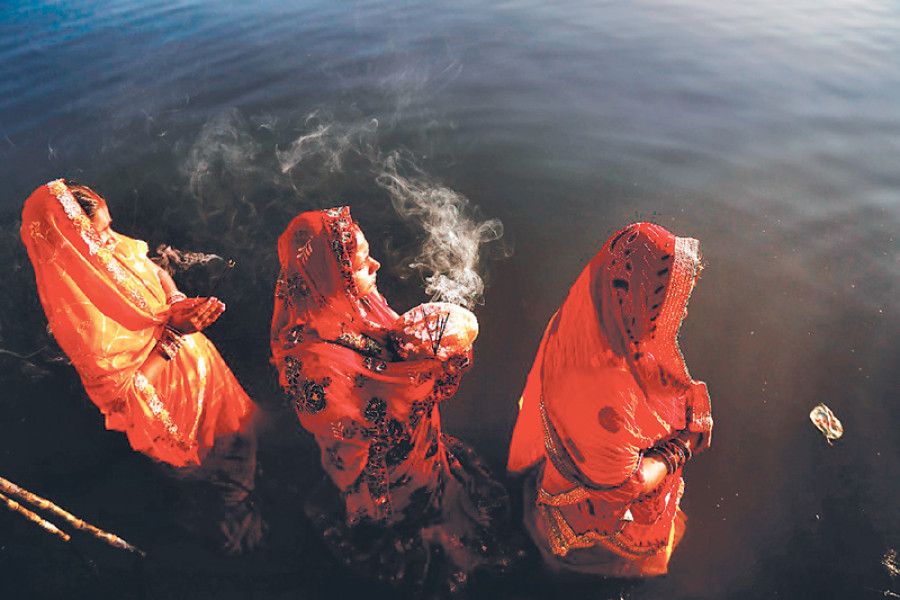Opinion
Sun worshippers
Devotees also believe that wishes are fulfilled by participating in the Chhath festival
Jitendra Sah
Last year, celebrants marked the Chhath festival in a kind of restless atmosphere due to a long strike and the blockade. Transportation problems prevented many from joining family and friends for the celebrations. This year, however, the mood was visibly radiant and colourful because there is peace in the land. The carnival has wonderfully expanded to the banks of ponds and rivers in the Capital following the open air brought about by the establishment of Loktantra. Celebrations have even been held at the historic pond of Rani Pokhari since 2006 while it was once limited to parts of the Tarai. People from every corner of Nepal living in Kathmandu got an opportunity to observe the sun worshipping rituals intimately. The festival became rapidly popular and it didn’t need any introduction or recognition. The question now is this: What sort of event is it?
The Madhesi people observe it under the leadership of a respected, elderly and healthy family member. There are more women devotees than men. It is a collective social event where various groups come to water bodies from home to perform the puja. They pray to the sun together and offer Thekuwa, Bhushuwa and coconuts. Believers worship the sun and its divine feature Usha as Chhathi Mata. The festival falls on the sixth day of the lunar fortnight, and is thus known variously as Chhath, Chhath, Chaith or Chhathi. The festival is a symbol of equality because people of all castes, communities and creeds join it from the beginning till the closing. This ancient folk festival follows a vegetarian menu. Not only the main devotees but also their family members don’t take meat, fish, garlic or onion during the four days of fasting. Purity and cleanliness are the cornerstones of the festival.
A democratic deity
There are many tales about the big ceremony in different countries and societies. The heart of all these is relief from disease and unbearable pain. Devotees also mark the festival to get children and to pray for the welfare of the family, society and mankind. They believe that it is only by praying to the sun that it is possible to get rid of darkness on earth. It is also believed that wishes are fulfilled by participating in the festival. Some devotees go to river banks to worship the sun by prostrating themselves the entire distance. Sun worship is practised in many civilisations in Africa, Asia, Europe and America. Many sun temples have been built in India since the second century BC.
The sun is a democratic deity. It provides light equally among the poor and the rich without any discrimination. Many traditions in the world worship only the rising sun. In contrast, Chhath celebrants pray to the setting sun and also the rising sun the next morning. Its symbolic message is that one should not be an opportunist and behave equally with all. It is said that bias between the so-called upper and lower castes still exists. But few people know that the offerings used in the festival are stored in bamboo containers made by the marginalised Dom community of the Tarai. The so-called high caste people go to the homes of this Dalit community to obtain these bamboo items for the puja. This illustrates the racial equality among the people here. The most touching side of the festival is that poor people celebrate it by begging. Some wealthy persons also beg on this occasion in accordance with a vow to do so if their wishes are fulfilled.
Benefits galore
The Chhath festival is also an occasion for singing. The songs which are about the sun’s glory and women’s suffering and enjoyment are sung in the course of preparing for the festival. These folk songs can make anyone emotional. It is correct to say that the rules and regulation of the Chhath festival are hidden in these songs. It is really incomplete without the songs. Finally, we know that the physical development of the world is impossible without solar energy. The balance of life and nature relies on the sun. We need the sun’s rays to keep us healthy. It is the main source of Vitamin D. The many methods of yoga and exercises are based on the principles of the sunbeam medical practice. We read and hear that the sun’s rays can cure troubles of the heart and joints besides curing headaches. The festival has taken this grand shape because of such a strong basis.
Water sources, rivers and ponds are cleaned for the occasion. This also clarifies the relationship between water and mankind. The festival has a wonderful appeal as it is performed in a big gathering. Joy is seen at every step with the banks of ponds and rivers decorated with lights like during Deepawali. The lovely tendency of the Nepali people to adopt one another’s customs has spread the festival to every corner of the country. Deepening social, cultural, religious and marital relations between Madhesis and Pahadis have also played an important role here. The festival has also shown prospects for geographical, religious and cultural tourism. The large number of tourists who gather at the places of worship are proof of it. The event can be a great source of revenue for the government if the Tourism Ministry makes efforts to publicise it.
Sah is senior sub-editor of Kantipur, Biratnagar




 7.12°C Kathmandu
7.12°C Kathmandu









%20(1).jpg&w=300&height=200)

